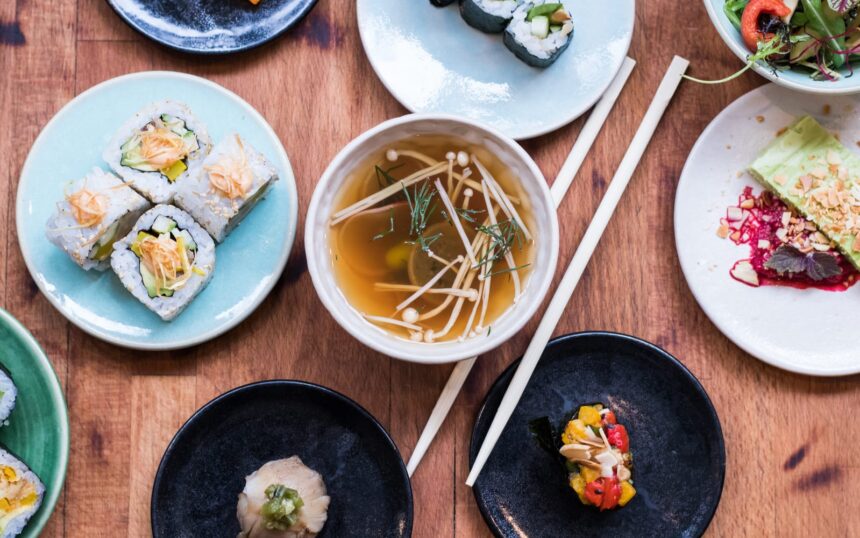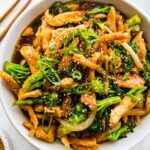Help keep One Green Planet free and independent! Together we can ensure our platform remains a hub for empowering ideas committed to fighting for a sustainable, healthy, and compassionate world. Please support us in keeping our mission strong.
Japanese cuisine is a big hit in America. We not only love both the clean, raw staples, such as sushi, and big, comforting bowls full of ramen, but we’ve appropriated them for convenience, too. Instant ramen lines the pantries of college dorms, and you can buy a plant-based roll of sushi at most convenient stores if you’re really in a time crunch.
We’re not here to hate on the simplified versions of the original dishes, but we do admit that even authentic and fresh ramen and sushi aren’t the be-all-end-all of Japanese cuisine. In fact, the Land of the Rising Sun offers all manners of culinary delights — you just need to know how to make them.
Below, we’re taking you through four essential Japanese cooking methods — master these four, and you’ll be well on your way to cooking up Japanese fare that spans beyond your basic avocado roll. We even included some recipes from the Food Monster App to help you get started.
1. Agemono 
Agemono is a kind of deep-fried dish in Japan. If you’ve ever had crispy tempura — battered and deep-fried ingredients — at a Japanese restaurant, you’ve had agemono before.
Agemono dishes include kaarage, which are traditionally bite-sized pieces of meat, like chicken or octopus, that are floured and deep fried, korokke (essentially croquettes), which are breaded and deep-fried patties, typically made of mashed potatoes and veggies, kushikatsu, which are skewers of deep-fried veggies, tempura, and agedashi dofu, which are cubes of deep-fried silken tofu that are then served in a hot, cozy broth.
If you want to give agemono dishes a go, try this recipe for 15-Minute Tempura Vegetables With Chili Dipping Sauce, pictured above, or this recipe for Japanese Deep-Fried Agedashi Tofu.
2. Mushimono
 yasuhiro amano/Shutterstock
yasuhiro amano/Shutterstock
Mushimono is a Japanese culinary term that refers to steamed dishes. Steaming ingredients (“muso”) essentially allows you to preserve both the flavor and nutritional value of your food, without any additional oil or grease.
One of the most famous Japanese mushimono dishes is chawan-mushi, which is a steamed egg and dashi (a soup stock) custard (we recommend this recipe for Chinese Steamed Custard Buns for a vegan Chinese alternative). Another is dobin-mushi, which features steamed matsutake mushrooms in a classic Autumn clear soup called suimono, garnished with seasonal items that were cooked in an earthenware pot.
Sweet mushimono dishes include steamed buns called manju and steamed sweet bread called mushi-pan.
You can try this recipe for Spicy Tofu Steamed Buns to get a hang of how to steam — however, we also recommend reading this guide on 6 Veggies You Should Try to Avoid Steaming so you can optimize the nutritional benefits of your food.
3. Nimono
 fuumi901/Shutterstock
fuumi901/Shutterstock
Nimino is a style of Japanese cooking that involves simmering or boiling a variety of ingredients together. Literally translated, nimono means “simmered (ni) things (mono)”.
Nimono differs from mushimono in that nimono dishes feature shiru (a salty, sweet, and umami-flavored broth made by combining dashi, which is a soup stock, soy sauce, mirin, and sake). A well-known subcategory of nimono, for example, is nabemono, a one-pot tabletop cookery method in which ingredients are simmered in shiru, and then typically dipped into a flavorful sauce.
To make dashi, we suggest using kombu or Shiitake mushrooms to make it plant-based (as dashi is traditionally made by combining kombu with bonito fish flakes). You can follow this recipe for Kake Udon to learn how.
Once you have your shiru, we recommend making nimono with ingredients such as kabocha (Japanese pumpkin) and other winter squash, carrots, burdock root, potatoes, celeriac, daikon, taro, daikon, tofu, bamboo shoots, konnyaku, lotus roots, and tempeh.
4. Yakimono
Any dishes that are grilled or pan-fried are called yakimono in Japan. While some of the best known are teriyaki (which traditionally features meat or tofu pan-fried marinated in a teriyaki mixture) or gyoza, which are pan-fried dumplings filled with veggies (check out these Dark Yaki Gyoza for a gothic twist on the classic), there are countless kinds of yakimono dishes to enjoy.
If you’re a fan of having things made “as you like”, try out Okonomiyaki: Savory Japanese Pancakes. Udon noodle fans will love this recipe for Japanese Stir-Fry Udon Noodles, while fans of the popular Japanese snack food onigiri, which are stuffed rice balls, will enjoy the recipe for Yaki Onigiri: Japanese Rice Balls With Sweet Potato and Avocado FIlling, pictured above.
More Japanese Recipes
Learn How to Cook Plant-Based Meals at Home
Reducing your meat intake and eating more plant-based foods is known to help with chronic inflammation, heart health, mental well-being, fitness goals, nutritional needs, allergies, gut health, and more! Dairy consumption also has been linked to many health problems, including acne, hormonal imbalance, cancer, and prostate cancer, and has many side effects.
For those of you interested in eating more plant-based we highly recommend grabbing our favorite plant-based cookbooks and downloading the Food Monster App — with over 20,000 delicious recipes it is the largest plant-based recipe resource to help reduce your environmental footprint, save animals, and get healthy! And, while you are at it, we encourage you to also learn about the environmental and health benefits of a plant-based diet.
Here are some great resources to get you started:
For more Animal, Earth, Life, Vegan Food, Health, and Recipe content published daily, subscribe to the One Green Planet Newsletter! Lastly, being publicly funded gives us a greater chance to continue providing you with high-quality content. Please consider supporting us by donating!






![Pull Apart Christmas Tree [Vegan] – One Green Planet](https://top-100-recipes.com/wp-content/uploads/2025/12/xscreen-shot-2019-11-29-at-1-57-39-pm-150x150.png.pagespeed.ic.9pB2mNa6N_.jpg)


